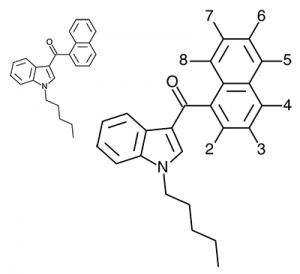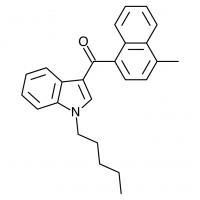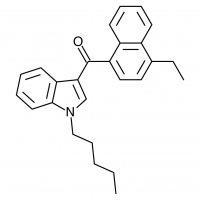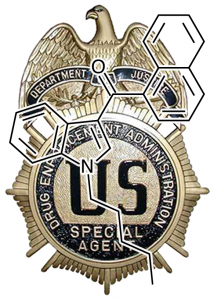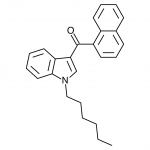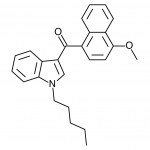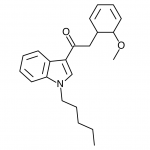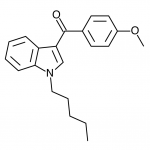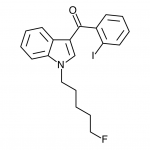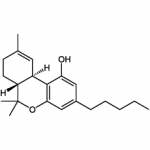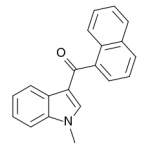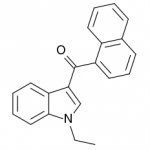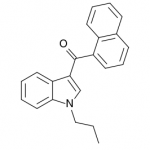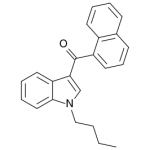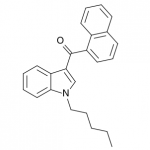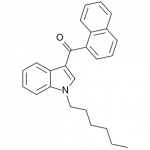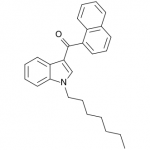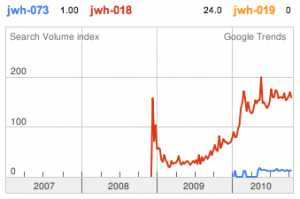Phenylacetylindoles
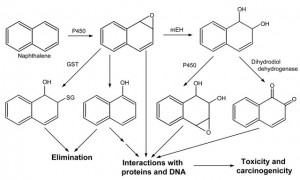 The alkylated napthoylindoles were the first synthetic cannabinoids cheap and potent enough to make real noise on the recreational drug market. Concern was initially raised about metabolism of the naphthalene ring and resulting carcinogenic risk, which turned out to be validated (abstract O43) although perhaps initially overstated as it lies within a similar risk envelope as cigarettes. Compounds have now been produced that replace the naphthalene ring with a phenylacetyl group. These represent a new and unique class of synthetic cannabinoids, with applications as both replacements for banned cannabinoids and use as a possibly healthier alternative for informed users. Without substitution the structure is much less potent than JWH-018, but various substitutions at the 2, 3, and 4-position have been attempted. The 2-position substitutions demonstrate the highest potency as a class, and are outlined here.
The alkylated napthoylindoles were the first synthetic cannabinoids cheap and potent enough to make real noise on the recreational drug market. Concern was initially raised about metabolism of the naphthalene ring and resulting carcinogenic risk, which turned out to be validated (abstract O43) although perhaps initially overstated as it lies within a similar risk envelope as cigarettes. Compounds have now been produced that replace the naphthalene ring with a phenylacetyl group. These represent a new and unique class of synthetic cannabinoids, with applications as both replacements for banned cannabinoids and use as a possibly healthier alternative for informed users. Without substitution the structure is much less potent than JWH-018, but various substitutions at the 2, 3, and 4-position have been attempted. The 2-position substitutions demonstrate the highest potency as a class, and are outlined here.

JWH-167 (CB1 Ki = 90 ± 17 nM, CB2 Ki = 159 ± 14 nM) is shown here with JWH-018 and its naphthalene group in a light grey underlay for reference. Without any substitutions this base phenylacetylindole is not potent enough for sale on the recreational drug market, as it is roughly a tenth as potent as JWH-018 as measured by binding affinity.

JWH-251 (CB1 Ki = 29 ± 3 nM, CB2 Ki = 146 ± 36 nM). A methyl group at the 2-position increases potency, but binding affinities seem to be too weak for practical sale. This is contrasted with the facts that JWH-251 was found to be a component of certain Japanese “herbal smoke” blends and limited reports indicate this to be of somewhat similar qualitative potency to JWH-250. Time will tell if this compound will remain on the edge of the market or gain popularity.
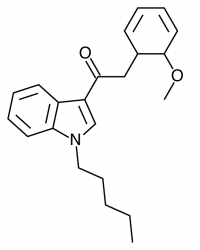
JWH-250 (CB1 Ki = 11 ± 2 nM, CB2 Ki = 33 ± 2 nM). Currently the most popular phenylacetylindole. The 2-methoxy substitution produces a compound that is qualitatively slightly less potent than JWH-018, but produces a much more pleasant effect in higher dose ranges. As such, this compound has found favor with those who prefer a stronger cannabinoid experience without the near-certainty of anxiety in higher doses that JWH-018 was known to cause.
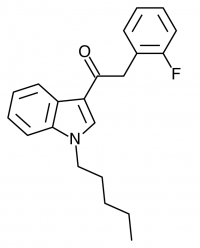
JWH-311 (CB1 Ki = 23 ± 2 nM, CB2 Ki = 39 ± 3 nM). Fluorine substitution provides the least potent outcome of the three halogens Huffman explored. Not widely available or tested.
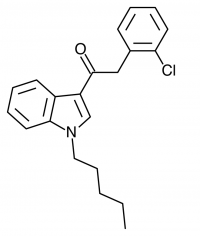
JWH-203 (CB1 Ki = 8.0 ± 0.9 nM, CB2 Ki = 7.0 ± 1.3 nM). The most potent halogen substitution, and one of the most potent phenylacetylindoles along with JWH-250. Currently available for sale, but not widely explored.
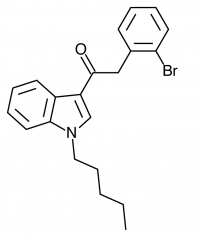
JWH-249 (CB1 Ki = 8.4 ± 1.8 nM, CB2 Ki = 20 ± 2 nM). Slightly less potent than JWH-203, with a lower CB2 affinity that may be associated with reduced anxiety effects. Not widely available for sale, but could be waiting in the wings if JWH-203 takes off and is scheduled.
John W. Huffman, P. V. Szklennik, A. Almond, K. Bushell, D. E. Selley, H. He, M. P. Cassidy, J. L. Wiley, B. R. Martin, 1-Pentyl-3-phenylacetylindoles, a new class of cannabimimetic indoles, Bioorganic & Medicinal Chemistry Letters, Volume 15, Issue 18, 15 September 2005, Pages 4110-4113, ISSN 0960-894X, DOI: 10.1016/j.bmcl.2005.06.008.
Burn it up, Thoughts on JWH-18 carcinogenicity, 01-05-2010, 02:22, Bluelight > Drug Discussion > Advanced Drug Discussion.
